Accounting Fundamentals Assignment: Income Statement and Balance Sheet
VerifiedAdded on 2023/06/08
|10
|2749
|169
Homework Assignment
AI Summary
This assignment delves into the core principles of accounting, focusing on the preparation of financial statements. It begins with the creation of an income statement and balance sheet based on provided trial balance data. The assignment then transitions to a detailed discussion of crucial accounting principles, such as the business entity concept, money measurement concept, dual aspect concept, going concern, cost concept, matching concept, realization concept, accrual concept, revenue recognition principle, economic entity principle, monetary unit principle and reliability principle. Furthermore, it covers the four main accounting conventions: conservatism, consistency, materiality, and full disclosure. The aim is to provide a comprehensive understanding of how these principles and conventions shape the recording, interpretation, and communication of financial information, ultimately aiding in informed decision-making.
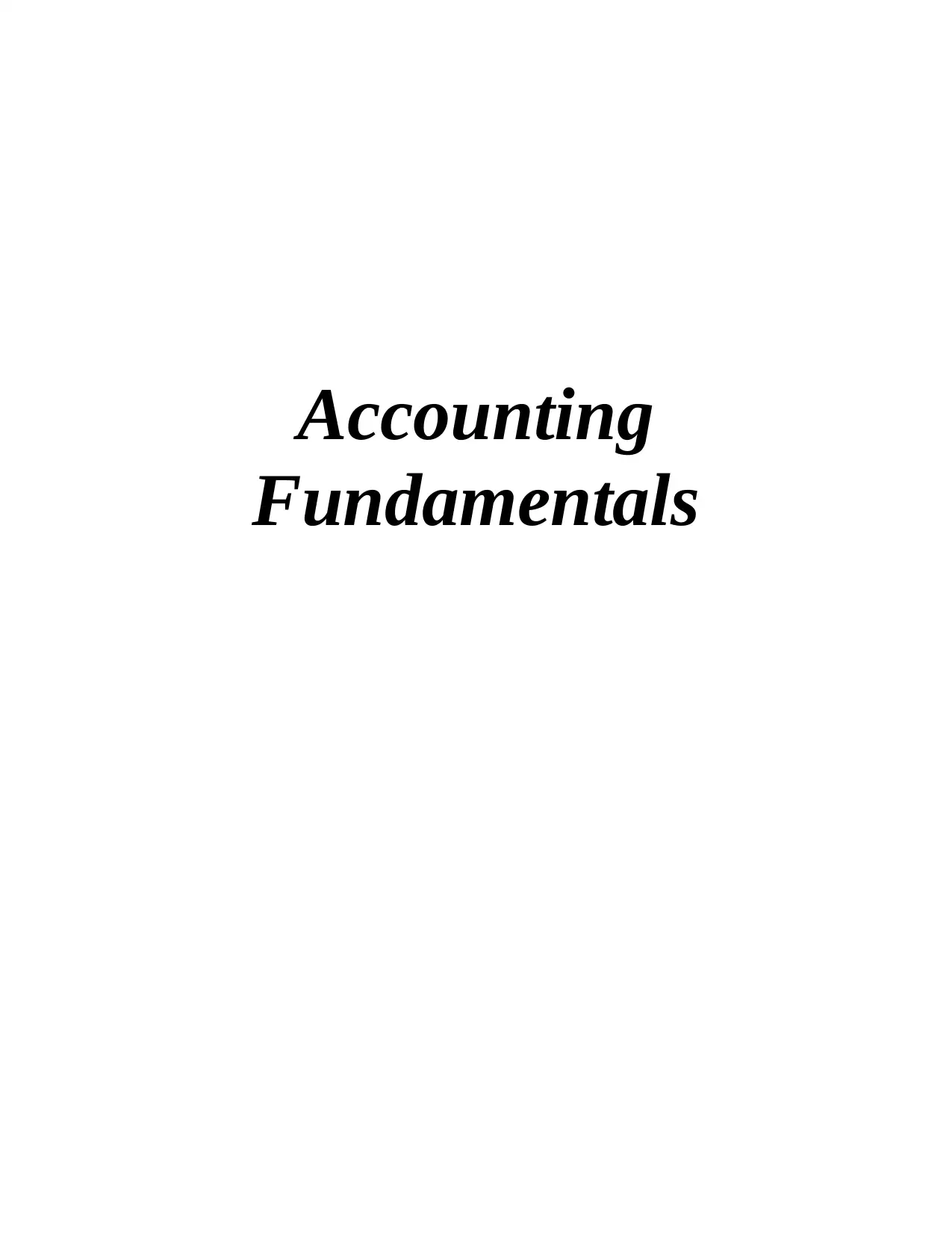
Accounting
Fundamentals
Fundamentals
Paraphrase This Document
Need a fresh take? Get an instant paraphrase of this document with our AI Paraphraser
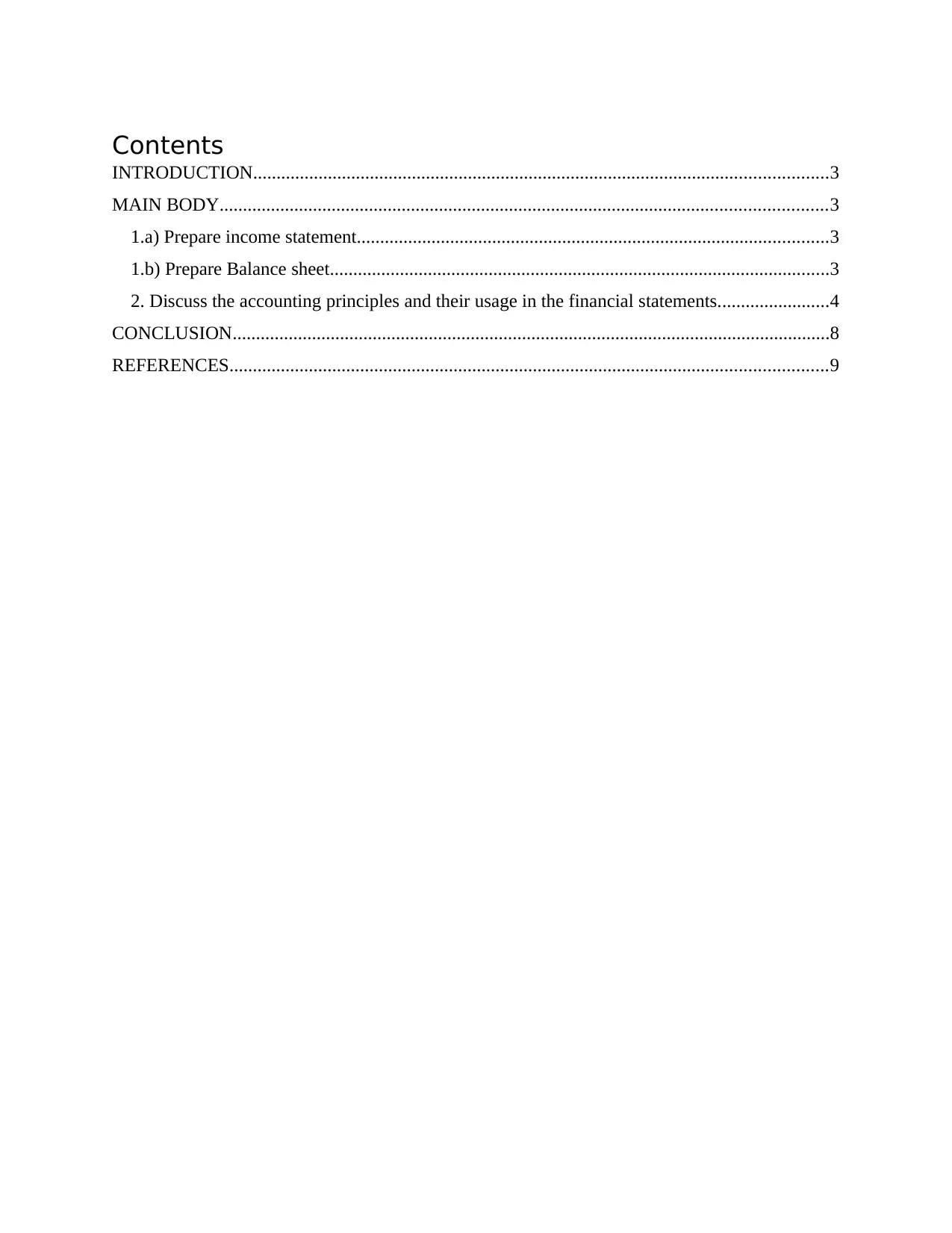
Contents
INTRODUCTION...........................................................................................................................3
MAIN BODY..................................................................................................................................3
1.a) Prepare income statement.....................................................................................................3
1.b) Prepare Balance sheet...........................................................................................................3
2. Discuss the accounting principles and their usage in the financial statements........................4
CONCLUSION................................................................................................................................8
REFERENCES................................................................................................................................9
INTRODUCTION...........................................................................................................................3
MAIN BODY..................................................................................................................................3
1.a) Prepare income statement.....................................................................................................3
1.b) Prepare Balance sheet...........................................................................................................3
2. Discuss the accounting principles and their usage in the financial statements........................4
CONCLUSION................................................................................................................................8
REFERENCES................................................................................................................................9
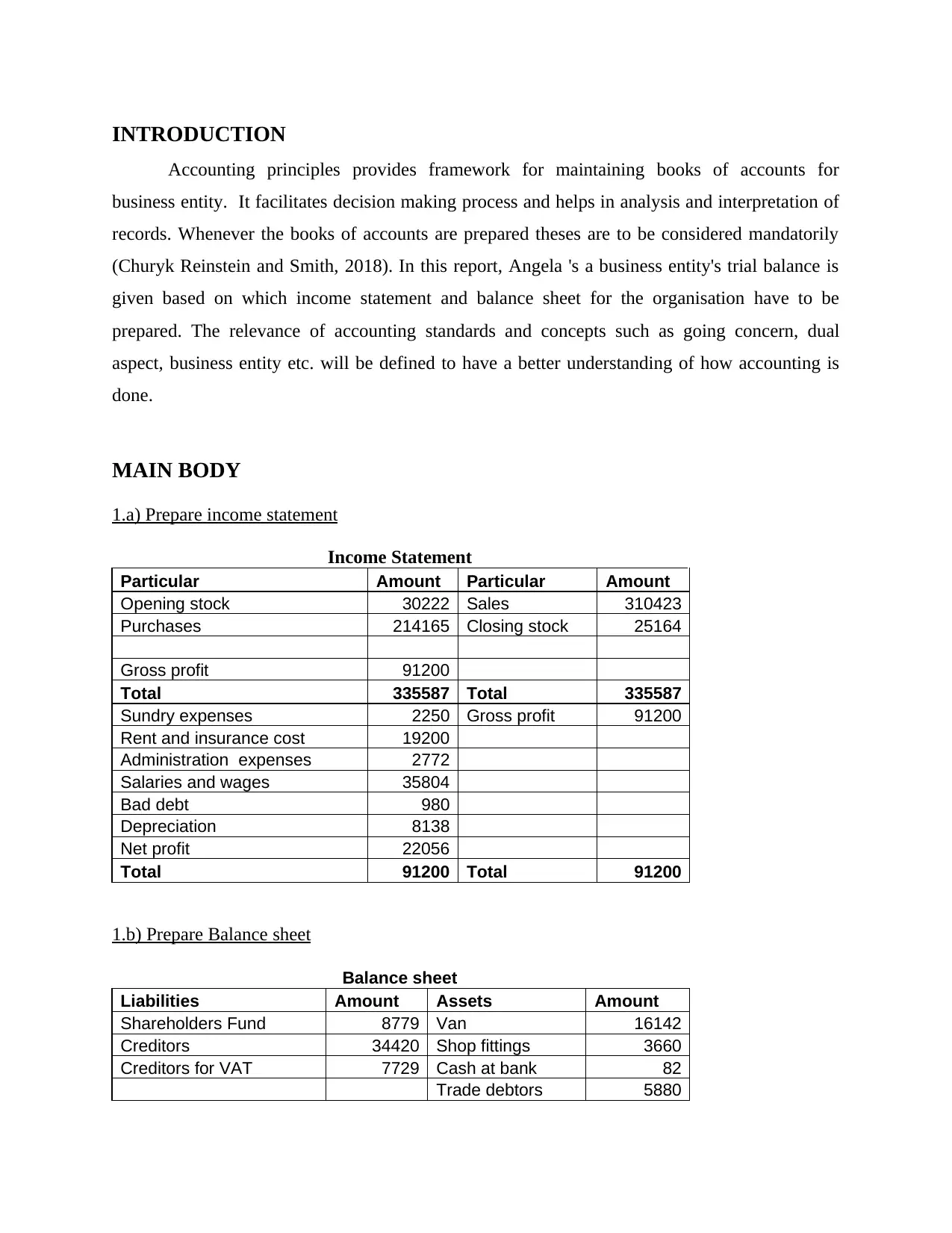
INTRODUCTION
Accounting principles provides framework for maintaining books of accounts for
business entity. It facilitates decision making process and helps in analysis and interpretation of
records. Whenever the books of accounts are prepared theses are to be considered mandatorily
(Churyk Reinstein and Smith, 2018). In this report, Angela 's a business entity's trial balance is
given based on which income statement and balance sheet for the organisation have to be
prepared. The relevance of accounting standards and concepts such as going concern, dual
aspect, business entity etc. will be defined to have a better understanding of how accounting is
done.
MAIN BODY
1.a) Prepare income statement
Income Statement
Particular Amount Particular Amount
Opening stock 30222 Sales 310423
Purchases 214165 Closing stock 25164
Gross profit 91200
Total 335587 Total 335587
Sundry expenses 2250 Gross profit 91200
Rent and insurance cost 19200
Administration expenses 2772
Salaries and wages 35804
Bad debt 980
Depreciation 8138
Net profit 22056
Total 91200 Total 91200
1.b) Prepare Balance sheet
Balance sheet
Liabilities Amount Assets Amount
Shareholders Fund 8779 Van 16142
Creditors 34420 Shop fittings 3660
Creditors for VAT 7729 Cash at bank 82
Trade debtors 5880
Accounting principles provides framework for maintaining books of accounts for
business entity. It facilitates decision making process and helps in analysis and interpretation of
records. Whenever the books of accounts are prepared theses are to be considered mandatorily
(Churyk Reinstein and Smith, 2018). In this report, Angela 's a business entity's trial balance is
given based on which income statement and balance sheet for the organisation have to be
prepared. The relevance of accounting standards and concepts such as going concern, dual
aspect, business entity etc. will be defined to have a better understanding of how accounting is
done.
MAIN BODY
1.a) Prepare income statement
Income Statement
Particular Amount Particular Amount
Opening stock 30222 Sales 310423
Purchases 214165 Closing stock 25164
Gross profit 91200
Total 335587 Total 335587
Sundry expenses 2250 Gross profit 91200
Rent and insurance cost 19200
Administration expenses 2772
Salaries and wages 35804
Bad debt 980
Depreciation 8138
Net profit 22056
Total 91200 Total 91200
1.b) Prepare Balance sheet
Balance sheet
Liabilities Amount Assets Amount
Shareholders Fund 8779 Van 16142
Creditors 34420 Shop fittings 3660
Creditors for VAT 7729 Cash at bank 82
Trade debtors 5880
⊘ This is a preview!⊘
Do you want full access?
Subscribe today to unlock all pages.

Trusted by 1+ million students worldwide
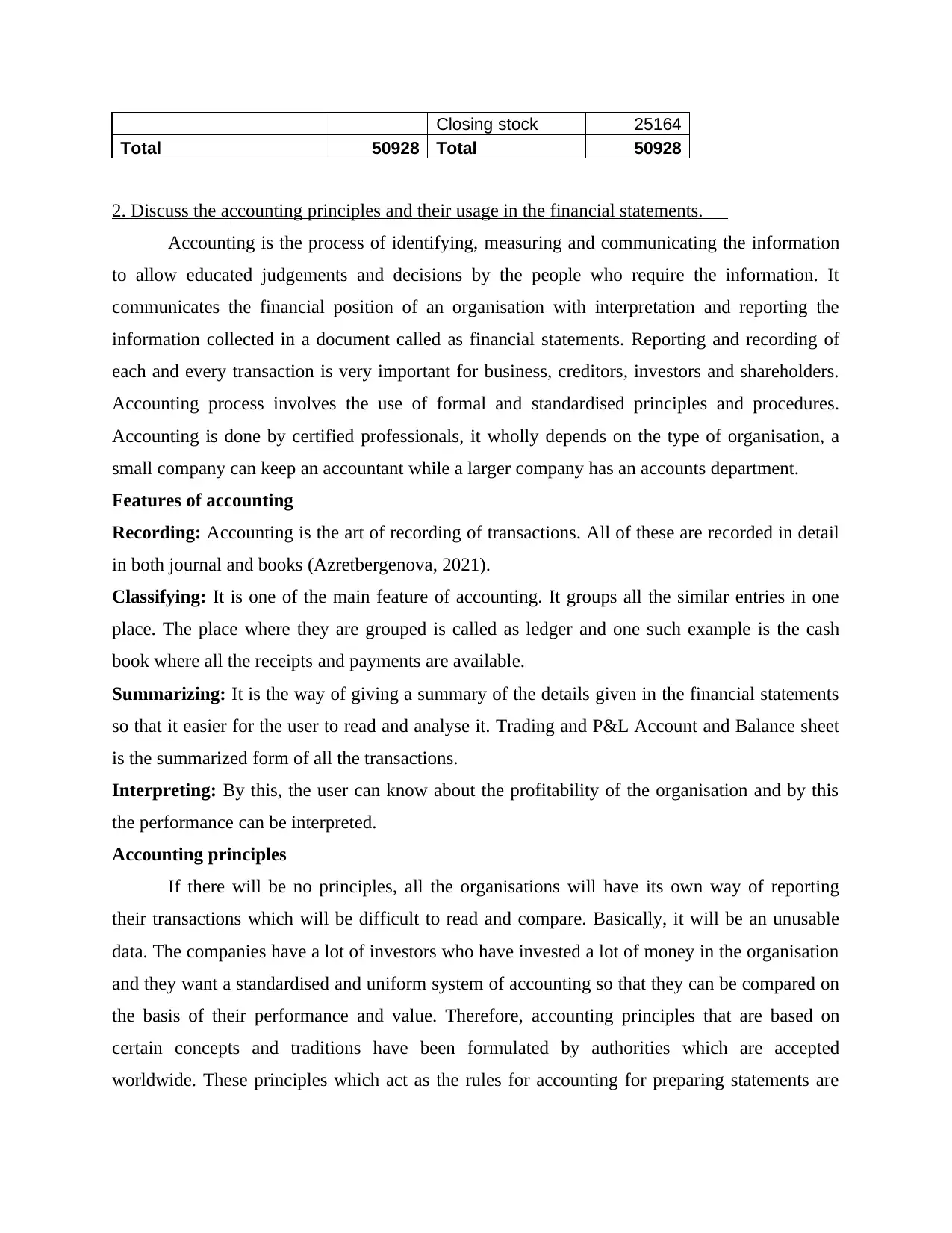
Closing stock 25164
Total 50928 Total 50928
2. Discuss the accounting principles and their usage in the financial statements.
Accounting is the process of identifying, measuring and communicating the information
to allow educated judgements and decisions by the people who require the information. It
communicates the financial position of an organisation with interpretation and reporting the
information collected in a document called as financial statements. Reporting and recording of
each and every transaction is very important for business, creditors, investors and shareholders.
Accounting process involves the use of formal and standardised principles and procedures.
Accounting is done by certified professionals, it wholly depends on the type of organisation, a
small company can keep an accountant while a larger company has an accounts department.
Features of accounting
Recording: Accounting is the art of recording of transactions. All of these are recorded in detail
in both journal and books (Azretbergenova, 2021).
Classifying: It is one of the main feature of accounting. It groups all the similar entries in one
place. The place where they are grouped is called as ledger and one such example is the cash
book where all the receipts and payments are available.
Summarizing: It is the way of giving a summary of the details given in the financial statements
so that it easier for the user to read and analyse it. Trading and P&L Account and Balance sheet
is the summarized form of all the transactions.
Interpreting: By this, the user can know about the profitability of the organisation and by this
the performance can be interpreted.
Accounting principles
If there will be no principles, all the organisations will have its own way of reporting
their transactions which will be difficult to read and compare. Basically, it will be an unusable
data. The companies have a lot of investors who have invested a lot of money in the organisation
and they want a standardised and uniform system of accounting so that they can be compared on
the basis of their performance and value. Therefore, accounting principles that are based on
certain concepts and traditions have been formulated by authorities which are accepted
worldwide. These principles which act as the rules for accounting for preparing statements are
Total 50928 Total 50928
2. Discuss the accounting principles and their usage in the financial statements.
Accounting is the process of identifying, measuring and communicating the information
to allow educated judgements and decisions by the people who require the information. It
communicates the financial position of an organisation with interpretation and reporting the
information collected in a document called as financial statements. Reporting and recording of
each and every transaction is very important for business, creditors, investors and shareholders.
Accounting process involves the use of formal and standardised principles and procedures.
Accounting is done by certified professionals, it wholly depends on the type of organisation, a
small company can keep an accountant while a larger company has an accounts department.
Features of accounting
Recording: Accounting is the art of recording of transactions. All of these are recorded in detail
in both journal and books (Azretbergenova, 2021).
Classifying: It is one of the main feature of accounting. It groups all the similar entries in one
place. The place where they are grouped is called as ledger and one such example is the cash
book where all the receipts and payments are available.
Summarizing: It is the way of giving a summary of the details given in the financial statements
so that it easier for the user to read and analyse it. Trading and P&L Account and Balance sheet
is the summarized form of all the transactions.
Interpreting: By this, the user can know about the profitability of the organisation and by this
the performance can be interpreted.
Accounting principles
If there will be no principles, all the organisations will have its own way of reporting
their transactions which will be difficult to read and compare. Basically, it will be an unusable
data. The companies have a lot of investors who have invested a lot of money in the organisation
and they want a standardised and uniform system of accounting so that they can be compared on
the basis of their performance and value. Therefore, accounting principles that are based on
certain concepts and traditions have been formulated by authorities which are accepted
worldwide. These principles which act as the rules for accounting for preparing statements are
Paraphrase This Document
Need a fresh take? Get an instant paraphrase of this document with our AI Paraphraser
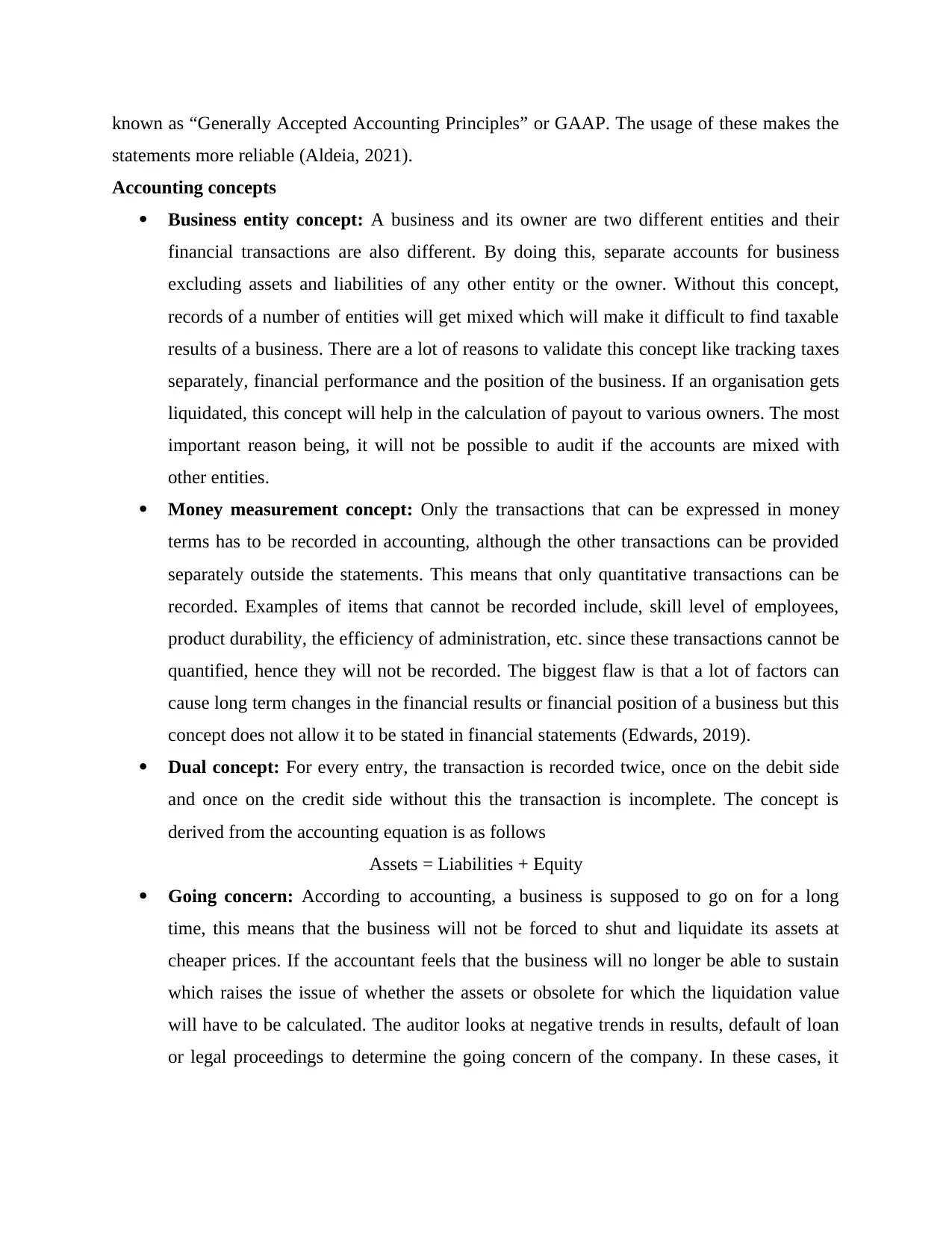
known as “Generally Accepted Accounting Principles” or GAAP. The usage of these makes the
statements more reliable (Aldeia, 2021).
Accounting concepts
Business entity concept: A business and its owner are two different entities and their
financial transactions are also different. By doing this, separate accounts for business
excluding assets and liabilities of any other entity or the owner. Without this concept,
records of a number of entities will get mixed which will make it difficult to find taxable
results of a business. There are a lot of reasons to validate this concept like tracking taxes
separately, financial performance and the position of the business. If an organisation gets
liquidated, this concept will help in the calculation of payout to various owners. The most
important reason being, it will not be possible to audit if the accounts are mixed with
other entities.
Money measurement concept: Only the transactions that can be expressed in money
terms has to be recorded in accounting, although the other transactions can be provided
separately outside the statements. This means that only quantitative transactions can be
recorded. Examples of items that cannot be recorded include, skill level of employees,
product durability, the efficiency of administration, etc. since these transactions cannot be
quantified, hence they will not be recorded. The biggest flaw is that a lot of factors can
cause long term changes in the financial results or financial position of a business but this
concept does not allow it to be stated in financial statements (Edwards, 2019).
Dual concept: For every entry, the transaction is recorded twice, once on the debit side
and once on the credit side without this the transaction is incomplete. The concept is
derived from the accounting equation is as follows
Assets = Liabilities + Equity
Going concern: According to accounting, a business is supposed to go on for a long
time, this means that the business will not be forced to shut and liquidate its assets at
cheaper prices. If the accountant feels that the business will no longer be able to sustain
which raises the issue of whether the assets or obsolete for which the liquidation value
will have to be calculated. The auditor looks at negative trends in results, default of loan
or legal proceedings to determine the going concern of the company. In these cases, it
statements more reliable (Aldeia, 2021).
Accounting concepts
Business entity concept: A business and its owner are two different entities and their
financial transactions are also different. By doing this, separate accounts for business
excluding assets and liabilities of any other entity or the owner. Without this concept,
records of a number of entities will get mixed which will make it difficult to find taxable
results of a business. There are a lot of reasons to validate this concept like tracking taxes
separately, financial performance and the position of the business. If an organisation gets
liquidated, this concept will help in the calculation of payout to various owners. The most
important reason being, it will not be possible to audit if the accounts are mixed with
other entities.
Money measurement concept: Only the transactions that can be expressed in money
terms has to be recorded in accounting, although the other transactions can be provided
separately outside the statements. This means that only quantitative transactions can be
recorded. Examples of items that cannot be recorded include, skill level of employees,
product durability, the efficiency of administration, etc. since these transactions cannot be
quantified, hence they will not be recorded. The biggest flaw is that a lot of factors can
cause long term changes in the financial results or financial position of a business but this
concept does not allow it to be stated in financial statements (Edwards, 2019).
Dual concept: For every entry, the transaction is recorded twice, once on the debit side
and once on the credit side without this the transaction is incomplete. The concept is
derived from the accounting equation is as follows
Assets = Liabilities + Equity
Going concern: According to accounting, a business is supposed to go on for a long
time, this means that the business will not be forced to shut and liquidate its assets at
cheaper prices. If the accountant feels that the business will no longer be able to sustain
which raises the issue of whether the assets or obsolete for which the liquidation value
will have to be calculated. The auditor looks at negative trends in results, default of loan
or legal proceedings to determine the going concern of the company. In these cases, it
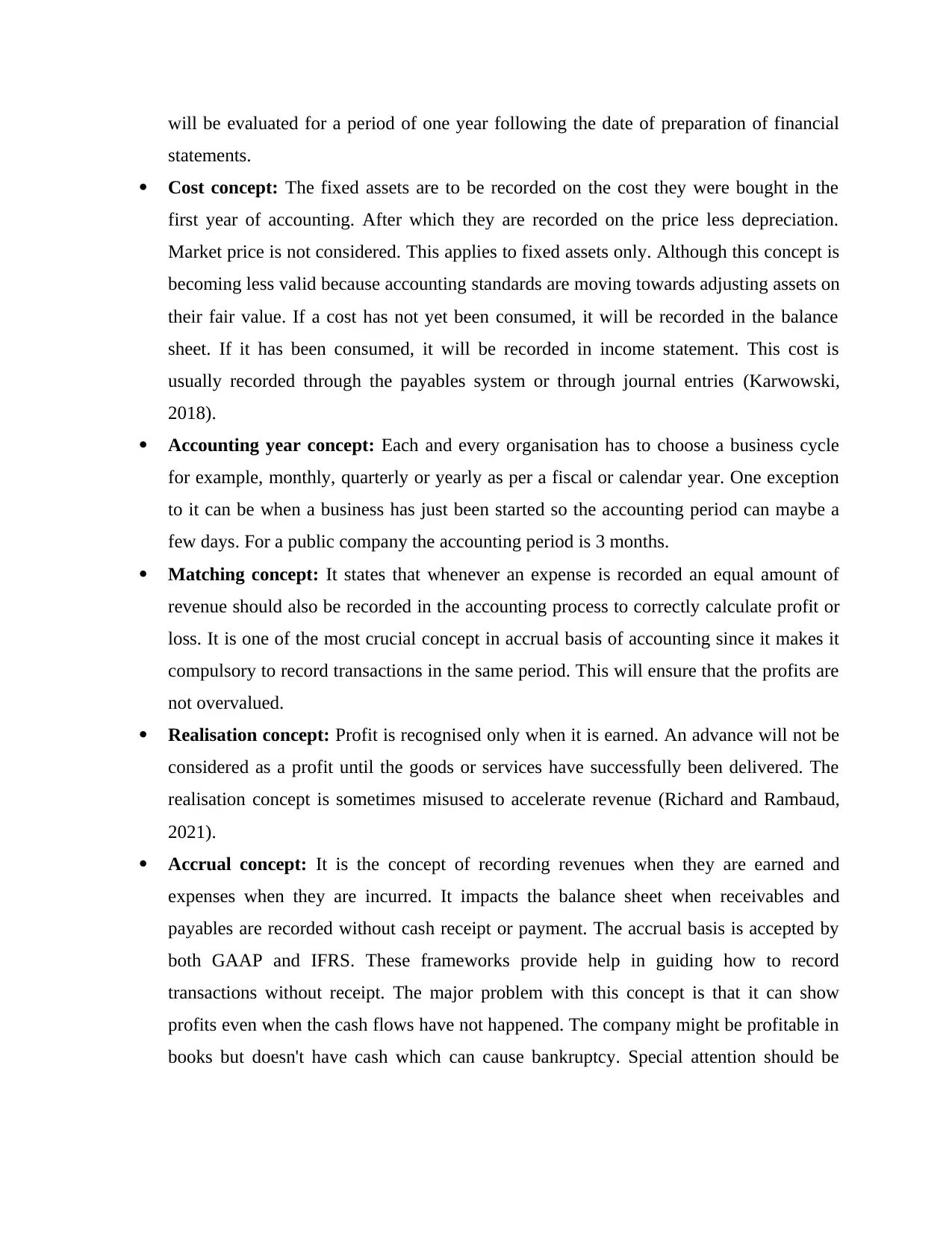
will be evaluated for a period of one year following the date of preparation of financial
statements.
Cost concept: The fixed assets are to be recorded on the cost they were bought in the
first year of accounting. After which they are recorded on the price less depreciation.
Market price is not considered. This applies to fixed assets only. Although this concept is
becoming less valid because accounting standards are moving towards adjusting assets on
their fair value. If a cost has not yet been consumed, it will be recorded in the balance
sheet. If it has been consumed, it will be recorded in income statement. This cost is
usually recorded through the payables system or through journal entries (Karwowski,
2018).
Accounting year concept: Each and every organisation has to choose a business cycle
for example, monthly, quarterly or yearly as per a fiscal or calendar year. One exception
to it can be when a business has just been started so the accounting period can maybe a
few days. For a public company the accounting period is 3 months.
Matching concept: It states that whenever an expense is recorded an equal amount of
revenue should also be recorded in the accounting process to correctly calculate profit or
loss. It is one of the most crucial concept in accrual basis of accounting since it makes it
compulsory to record transactions in the same period. This will ensure that the profits are
not overvalued.
Realisation concept: Profit is recognised only when it is earned. An advance will not be
considered as a profit until the goods or services have successfully been delivered. The
realisation concept is sometimes misused to accelerate revenue (Richard and Rambaud,
2021).
Accrual concept: It is the concept of recording revenues when they are earned and
expenses when they are incurred. It impacts the balance sheet when receivables and
payables are recorded without cash receipt or payment. The accrual basis is accepted by
both GAAP and IFRS. These frameworks provide help in guiding how to record
transactions without receipt. The major problem with this concept is that it can show
profits even when the cash flows have not happened. The company might be profitable in
books but doesn't have cash which can cause bankruptcy. Special attention should be
statements.
Cost concept: The fixed assets are to be recorded on the cost they were bought in the
first year of accounting. After which they are recorded on the price less depreciation.
Market price is not considered. This applies to fixed assets only. Although this concept is
becoming less valid because accounting standards are moving towards adjusting assets on
their fair value. If a cost has not yet been consumed, it will be recorded in the balance
sheet. If it has been consumed, it will be recorded in income statement. This cost is
usually recorded through the payables system or through journal entries (Karwowski,
2018).
Accounting year concept: Each and every organisation has to choose a business cycle
for example, monthly, quarterly or yearly as per a fiscal or calendar year. One exception
to it can be when a business has just been started so the accounting period can maybe a
few days. For a public company the accounting period is 3 months.
Matching concept: It states that whenever an expense is recorded an equal amount of
revenue should also be recorded in the accounting process to correctly calculate profit or
loss. It is one of the most crucial concept in accrual basis of accounting since it makes it
compulsory to record transactions in the same period. This will ensure that the profits are
not overvalued.
Realisation concept: Profit is recognised only when it is earned. An advance will not be
considered as a profit until the goods or services have successfully been delivered. The
realisation concept is sometimes misused to accelerate revenue (Richard and Rambaud,
2021).
Accrual concept: It is the concept of recording revenues when they are earned and
expenses when they are incurred. It impacts the balance sheet when receivables and
payables are recorded without cash receipt or payment. The accrual basis is accepted by
both GAAP and IFRS. These frameworks provide help in guiding how to record
transactions without receipt. The major problem with this concept is that it can show
profits even when the cash flows have not happened. The company might be profitable in
books but doesn't have cash which can cause bankruptcy. Special attention should be
⊘ This is a preview!⊘
Do you want full access?
Subscribe today to unlock all pages.

Trusted by 1+ million students worldwide
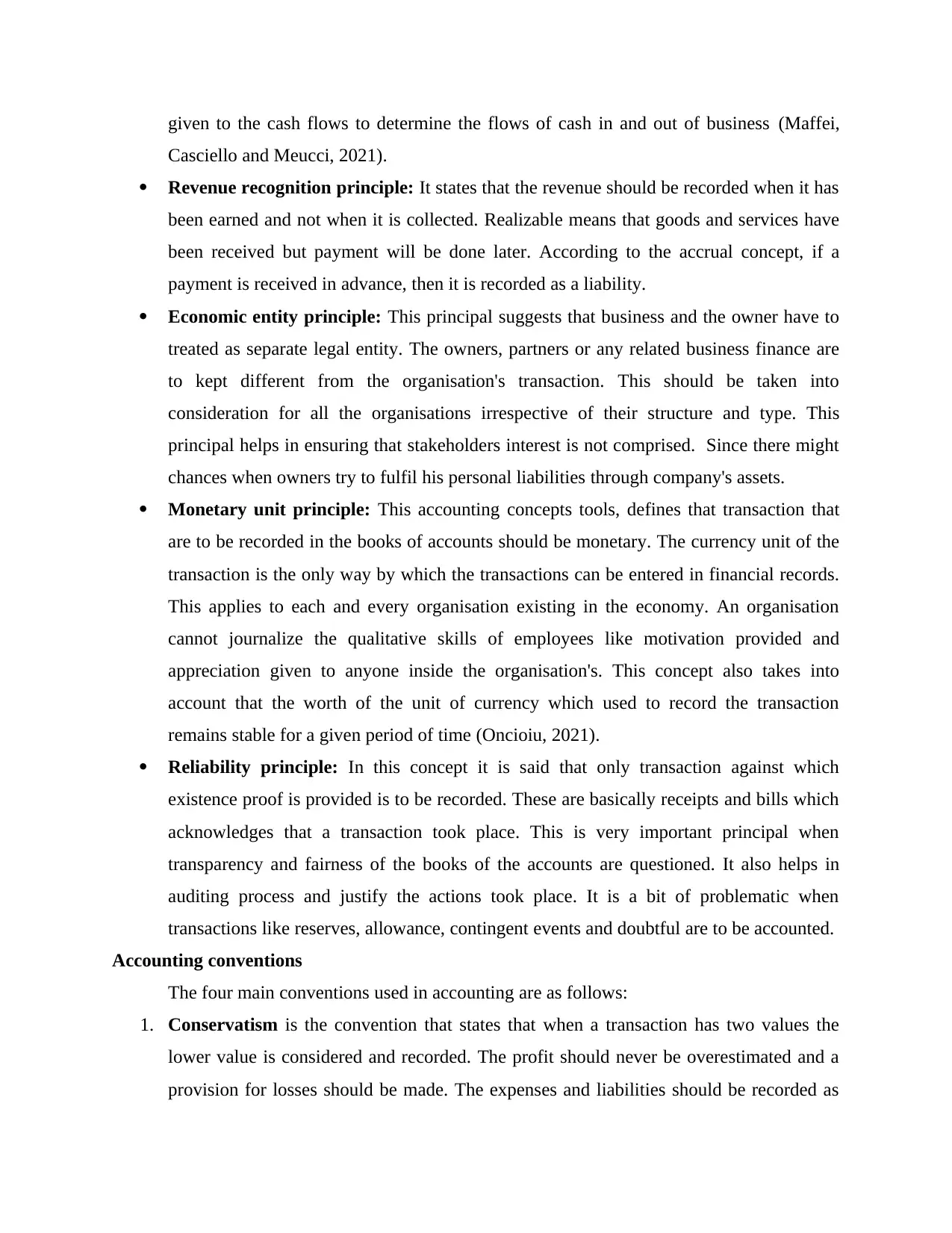
given to the cash flows to determine the flows of cash in and out of business (Maffei,
Casciello and Meucci, 2021).
Revenue recognition principle: It states that the revenue should be recorded when it has
been earned and not when it is collected. Realizable means that goods and services have
been received but payment will be done later. According to the accrual concept, if a
payment is received in advance, then it is recorded as a liability.
Economic entity principle: This principal suggests that business and the owner have to
treated as separate legal entity. The owners, partners or any related business finance are
to kept different from the organisation's transaction. This should be taken into
consideration for all the organisations irrespective of their structure and type. This
principal helps in ensuring that stakeholders interest is not comprised. Since there might
chances when owners try to fulfil his personal liabilities through company's assets.
Monetary unit principle: This accounting concepts tools, defines that transaction that
are to be recorded in the books of accounts should be monetary. The currency unit of the
transaction is the only way by which the transactions can be entered in financial records.
This applies to each and every organisation existing in the economy. An organisation
cannot journalize the qualitative skills of employees like motivation provided and
appreciation given to anyone inside the organisation's. This concept also takes into
account that the worth of the unit of currency which used to record the transaction
remains stable for a given period of time (Oncioiu, 2021).
Reliability principle: In this concept it is said that only transaction against which
existence proof is provided is to be recorded. These are basically receipts and bills which
acknowledges that a transaction took place. This is very important principal when
transparency and fairness of the books of the accounts are questioned. It also helps in
auditing process and justify the actions took place. It is a bit of problematic when
transactions like reserves, allowance, contingent events and doubtful are to be accounted.
Accounting conventions
The four main conventions used in accounting are as follows:
1. Conservatism is the convention that states that when a transaction has two values the
lower value is considered and recorded. The profit should never be overestimated and a
provision for losses should be made. The expenses and liabilities should be recorded as
Casciello and Meucci, 2021).
Revenue recognition principle: It states that the revenue should be recorded when it has
been earned and not when it is collected. Realizable means that goods and services have
been received but payment will be done later. According to the accrual concept, if a
payment is received in advance, then it is recorded as a liability.
Economic entity principle: This principal suggests that business and the owner have to
treated as separate legal entity. The owners, partners or any related business finance are
to kept different from the organisation's transaction. This should be taken into
consideration for all the organisations irrespective of their structure and type. This
principal helps in ensuring that stakeholders interest is not comprised. Since there might
chances when owners try to fulfil his personal liabilities through company's assets.
Monetary unit principle: This accounting concepts tools, defines that transaction that
are to be recorded in the books of accounts should be monetary. The currency unit of the
transaction is the only way by which the transactions can be entered in financial records.
This applies to each and every organisation existing in the economy. An organisation
cannot journalize the qualitative skills of employees like motivation provided and
appreciation given to anyone inside the organisation's. This concept also takes into
account that the worth of the unit of currency which used to record the transaction
remains stable for a given period of time (Oncioiu, 2021).
Reliability principle: In this concept it is said that only transaction against which
existence proof is provided is to be recorded. These are basically receipts and bills which
acknowledges that a transaction took place. This is very important principal when
transparency and fairness of the books of the accounts are questioned. It also helps in
auditing process and justify the actions took place. It is a bit of problematic when
transactions like reserves, allowance, contingent events and doubtful are to be accounted.
Accounting conventions
The four main conventions used in accounting are as follows:
1. Conservatism is the convention that states that when a transaction has two values the
lower value is considered and recorded. The profit should never be overestimated and a
provision for losses should be made. The expenses and liabilities should be recorded as
Paraphrase This Document
Need a fresh take? Get an instant paraphrase of this document with our AI Paraphraser
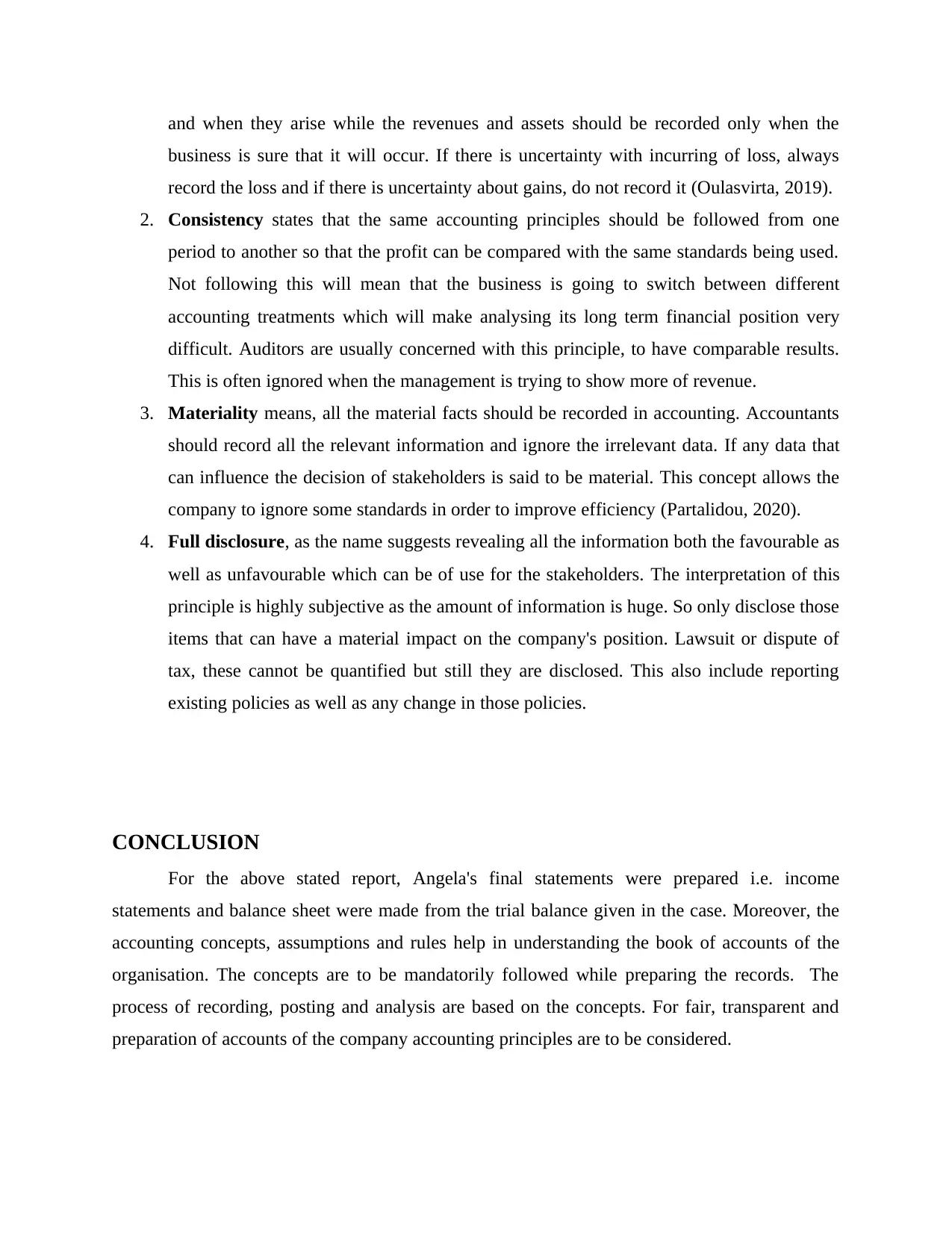
and when they arise while the revenues and assets should be recorded only when the
business is sure that it will occur. If there is uncertainty with incurring of loss, always
record the loss and if there is uncertainty about gains, do not record it (Oulasvirta, 2019).
2. Consistency states that the same accounting principles should be followed from one
period to another so that the profit can be compared with the same standards being used.
Not following this will mean that the business is going to switch between different
accounting treatments which will make analysing its long term financial position very
difficult. Auditors are usually concerned with this principle, to have comparable results.
This is often ignored when the management is trying to show more of revenue.
3. Materiality means, all the material facts should be recorded in accounting. Accountants
should record all the relevant information and ignore the irrelevant data. If any data that
can influence the decision of stakeholders is said to be material. This concept allows the
company to ignore some standards in order to improve efficiency (Partalidou, 2020).
4. Full disclosure, as the name suggests revealing all the information both the favourable as
well as unfavourable which can be of use for the stakeholders. The interpretation of this
principle is highly subjective as the amount of information is huge. So only disclose those
items that can have a material impact on the company's position. Lawsuit or dispute of
tax, these cannot be quantified but still they are disclosed. This also include reporting
existing policies as well as any change in those policies.
CONCLUSION
For the above stated report, Angela's final statements were prepared i.e. income
statements and balance sheet were made from the trial balance given in the case. Moreover, the
accounting concepts, assumptions and rules help in understanding the book of accounts of the
organisation. The concepts are to be mandatorily followed while preparing the records. The
process of recording, posting and analysis are based on the concepts. For fair, transparent and
preparation of accounts of the company accounting principles are to be considered.
business is sure that it will occur. If there is uncertainty with incurring of loss, always
record the loss and if there is uncertainty about gains, do not record it (Oulasvirta, 2019).
2. Consistency states that the same accounting principles should be followed from one
period to another so that the profit can be compared with the same standards being used.
Not following this will mean that the business is going to switch between different
accounting treatments which will make analysing its long term financial position very
difficult. Auditors are usually concerned with this principle, to have comparable results.
This is often ignored when the management is trying to show more of revenue.
3. Materiality means, all the material facts should be recorded in accounting. Accountants
should record all the relevant information and ignore the irrelevant data. If any data that
can influence the decision of stakeholders is said to be material. This concept allows the
company to ignore some standards in order to improve efficiency (Partalidou, 2020).
4. Full disclosure, as the name suggests revealing all the information both the favourable as
well as unfavourable which can be of use for the stakeholders. The interpretation of this
principle is highly subjective as the amount of information is huge. So only disclose those
items that can have a material impact on the company's position. Lawsuit or dispute of
tax, these cannot be quantified but still they are disclosed. This also include reporting
existing policies as well as any change in those policies.
CONCLUSION
For the above stated report, Angela's final statements were prepared i.e. income
statements and balance sheet were made from the trial balance given in the case. Moreover, the
accounting concepts, assumptions and rules help in understanding the book of accounts of the
organisation. The concepts are to be mandatorily followed while preparing the records. The
process of recording, posting and analysis are based on the concepts. For fair, transparent and
preparation of accounts of the company accounting principles are to be considered.
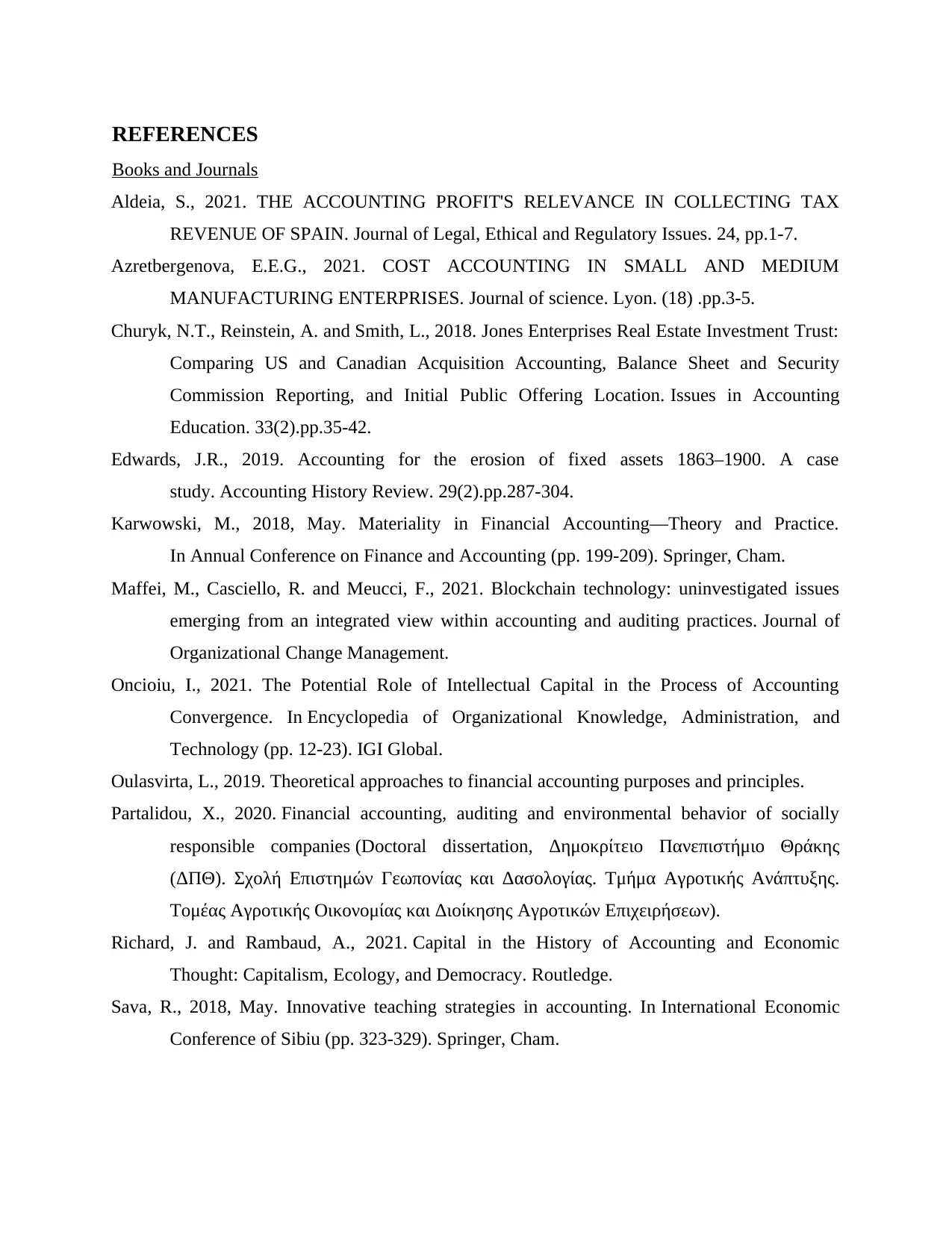
REFERENCES
Books and Journals
Aldeia, S., 2021. THE ACCOUNTING PROFIT'S RELEVANCE IN COLLECTING TAX
REVENUE OF SPAIN. Journal of Legal, Ethical and Regulatory Issues. 24, pp.1-7.
Azretbergenova, E.E.G., 2021. COST ACCOUNTING IN SMALL AND MEDIUM
MANUFACTURING ENTERPRISES. Journal of science. Lyon. (18) .pp.3-5.
Churyk, N.T., Reinstein, A. and Smith, L., 2018. Jones Enterprises Real Estate Investment Trust:
Comparing US and Canadian Acquisition Accounting, Balance Sheet and Security
Commission Reporting, and Initial Public Offering Location. Issues in Accounting
Education. 33(2).pp.35-42.
Edwards, J.R., 2019. Accounting for the erosion of fixed assets 1863–1900. A case
study. Accounting History Review. 29(2).pp.287-304.
Karwowski, M., 2018, May. Materiality in Financial Accounting—Theory and Practice.
In Annual Conference on Finance and Accounting (pp. 199-209). Springer, Cham.
Maffei, M., Casciello, R. and Meucci, F., 2021. Blockchain technology: uninvestigated issues
emerging from an integrated view within accounting and auditing practices. Journal of
Organizational Change Management.
Oncioiu, I., 2021. The Potential Role of Intellectual Capital in the Process of Accounting
Convergence. In Encyclopedia of Organizational Knowledge, Administration, and
Technology (pp. 12-23). IGI Global.
Oulasvirta, L., 2019. Theoretical approaches to financial accounting purposes and principles.
Partalidou, X., 2020. Financial accounting, auditing and environmental behavior of socially
responsible companies (Doctoral dissertation, Δημοκρίτειο Πανεπιστήμιο Θράκης
(ΔΠΘ). Σχολή Επιστημών Γεωπονίας και Δασολογίας. Τμήμα Αγροτικής Ανάπτυξης.
Τομέας Αγροτικής Οικονομίας και Διοίκησης Αγροτικών Επιχειρήσεων).
Richard, J. and Rambaud, A., 2021. Capital in the History of Accounting and Economic
Thought: Capitalism, Ecology, and Democracy. Routledge.
Sava, R., 2018, May. Innovative teaching strategies in accounting. In International Economic
Conference of Sibiu (pp. 323-329). Springer, Cham.
Books and Journals
Aldeia, S., 2021. THE ACCOUNTING PROFIT'S RELEVANCE IN COLLECTING TAX
REVENUE OF SPAIN. Journal of Legal, Ethical and Regulatory Issues. 24, pp.1-7.
Azretbergenova, E.E.G., 2021. COST ACCOUNTING IN SMALL AND MEDIUM
MANUFACTURING ENTERPRISES. Journal of science. Lyon. (18) .pp.3-5.
Churyk, N.T., Reinstein, A. and Smith, L., 2018. Jones Enterprises Real Estate Investment Trust:
Comparing US and Canadian Acquisition Accounting, Balance Sheet and Security
Commission Reporting, and Initial Public Offering Location. Issues in Accounting
Education. 33(2).pp.35-42.
Edwards, J.R., 2019. Accounting for the erosion of fixed assets 1863–1900. A case
study. Accounting History Review. 29(2).pp.287-304.
Karwowski, M., 2018, May. Materiality in Financial Accounting—Theory and Practice.
In Annual Conference on Finance and Accounting (pp. 199-209). Springer, Cham.
Maffei, M., Casciello, R. and Meucci, F., 2021. Blockchain technology: uninvestigated issues
emerging from an integrated view within accounting and auditing practices. Journal of
Organizational Change Management.
Oncioiu, I., 2021. The Potential Role of Intellectual Capital in the Process of Accounting
Convergence. In Encyclopedia of Organizational Knowledge, Administration, and
Technology (pp. 12-23). IGI Global.
Oulasvirta, L., 2019. Theoretical approaches to financial accounting purposes and principles.
Partalidou, X., 2020. Financial accounting, auditing and environmental behavior of socially
responsible companies (Doctoral dissertation, Δημοκρίτειο Πανεπιστήμιο Θράκης
(ΔΠΘ). Σχολή Επιστημών Γεωπονίας και Δασολογίας. Τμήμα Αγροτικής Ανάπτυξης.
Τομέας Αγροτικής Οικονομίας και Διοίκησης Αγροτικών Επιχειρήσεων).
Richard, J. and Rambaud, A., 2021. Capital in the History of Accounting and Economic
Thought: Capitalism, Ecology, and Democracy. Routledge.
Sava, R., 2018, May. Innovative teaching strategies in accounting. In International Economic
Conference of Sibiu (pp. 323-329). Springer, Cham.
⊘ This is a preview!⊘
Do you want full access?
Subscribe today to unlock all pages.

Trusted by 1+ million students worldwide
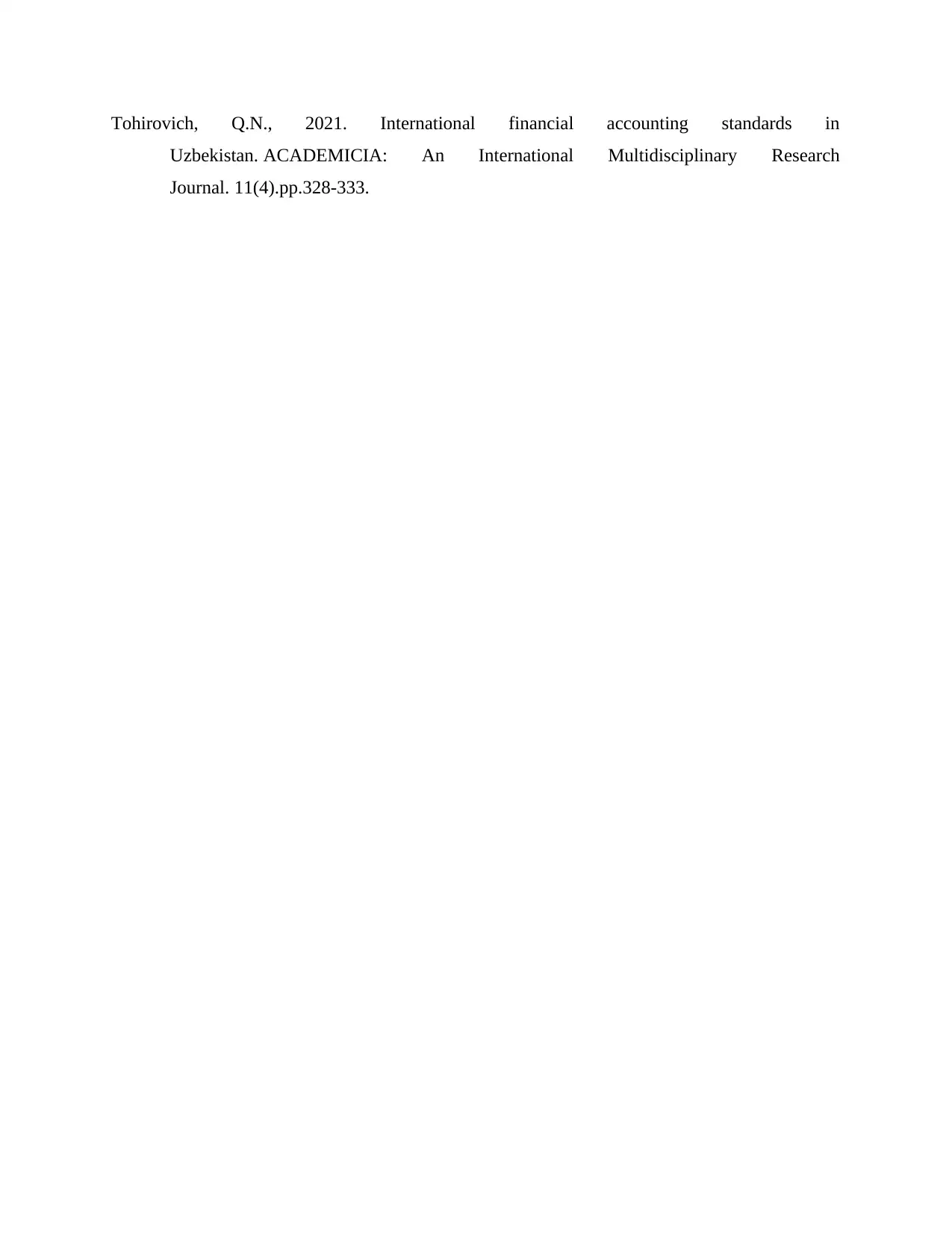
Tohirovich, Q.N., 2021. International financial accounting standards in
Uzbekistan. ACADEMICIA: An International Multidisciplinary Research
Journal. 11(4).pp.328-333.
Uzbekistan. ACADEMICIA: An International Multidisciplinary Research
Journal. 11(4).pp.328-333.
1 out of 10
Related Documents
Your All-in-One AI-Powered Toolkit for Academic Success.
+13062052269
info@desklib.com
Available 24*7 on WhatsApp / Email
![[object Object]](/_next/static/media/star-bottom.7253800d.svg)
Unlock your academic potential
Copyright © 2020–2025 A2Z Services. All Rights Reserved. Developed and managed by ZUCOL.





